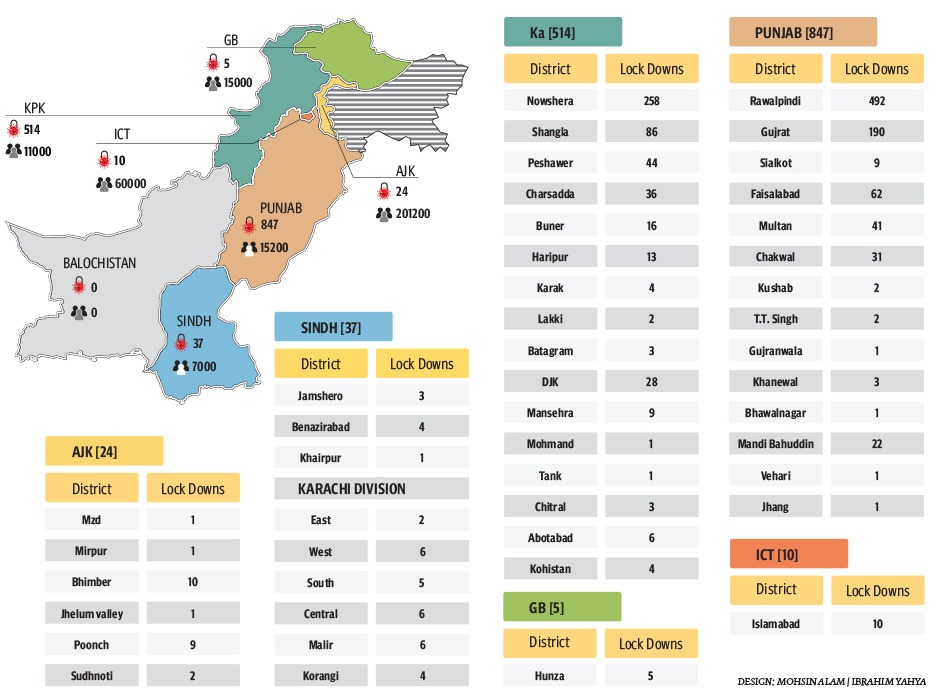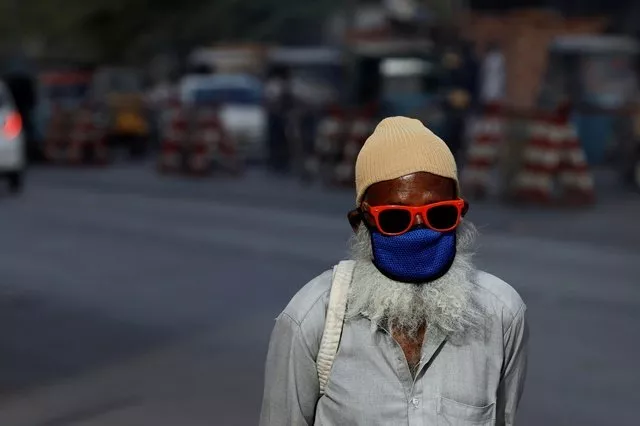Why fear frenzy over Pakistan's virus spurt?
Covid-19 projections appear grim each day but NCOC insists they have short, mid and long-term strategies in place
KARACHI: The post-lockdown virus surge has set off nationwide frenzy of fear. Every day we cross a new grim milestone. Every day our media prefixes the infections tally and death toll with ‘biggest’, ‘largest’ or ‘deadliest’. Overused, these superlatives are now losing their intended effect.Per media reports, hospitals have no or little space left for more patients. The situation is grim. And the projections are grimmer. Dispirited by the deluge of cases, people are increasingly questioning the government’s strategy (or lack thereof) to stem the tide and stamp out the deadly zoonotic disease. The nation has been left at the mercy of virus, they believe.

The government hasn’t been caught off-guard. Background interviews with officials at the NCOC – the situation room in the nation’s anti-Covid battle – show the virus spike is not something out of the blue. “It wasn’t unexpected. We knew the infections might climb post generalised lockdown,” one official said. The guesstimate, however, was a few thousand less infections than the current numbers on the official dashboard.
The cases are projected to double, to 300,000, by the end of this month – and to 1.2 million by July-end. Scary, right? But these projections have a big ‘if’ attached. We can make these numbers a lot less scary, if we stop flouting the health SOPs. Nonetheless, the officials say they have contingencies in place even for the worst-case scenarios.
Pakistan’s first Covid-19 case was confirmed on Feb 26 in a Karachi student who was believed to have carried the virus from Iran. The initial official response was out-of-synch. But the government quickly put its act together as cases started multiplying.
Going by the default playbook, the federal authorities on March 13 plugged the borders, suspended flight operations, shut educational institutions, and banned gatherings – before finally going for a nationwide lockdown. Sindh, however, refused to fly with the flock. And the chief minister earned a few early brownie points for his solo flight on lockdown, which as it turned out was ill conceived and crudely implemented.
Officially, everything is in synch now. And there’s synergy among all stakeholders. But the situation is far from ideal, say sources. The federal government is now gradually imposing ‘smart lockdowns’ in virus hotspots in 20 cities nationwide. All provincial governments and authorities in AJK and G-B were asked to identify specific areas with virus clusters. All regions immediately complied but Sindh dilly-dallied until early Thursday, according to sources.
Smart lockdown only solution, reiterates PM Imran as Covid-19 tally soars to 157,824
The federal government has drawn a lot of flak – first for its reluctance on lockdown, and then for easing it ‘abruptly’. Prime Minister Imran Khan has consistently said Pakistan doesn’t have the financial wherewithal to sustain a prolonged lockdown. Why? Because the government fears around 18 million job losses, 55% increase in poverty, impacting a population of 110 million, and an increase in malnutrition, which would reduce immunity to disease.
“Policy choices are tough. We have to strike a balance between saving lives and livelihoods,” the official said. “We’ve consciously but gradually eased generalised lockdowns but at the same time we’ve focused on enforcement of SOPs in shops, industry, mosques and public transport, etc.”
The officials defend the ‘timely projections and effective interventions’ of the government. According to them, Pakistan followed a well-thought-out plan based on ‘best in the world’ practices and successful models, like China. The official strategy was three-pronged: Building structures (NCC, NCOC, NDMA, etc); resource generation; and human resource development. And the strategy revolves around disease spread control through prevention, mitigation and management; capacity enhancement of healthcare system; and continued assessment of the situation.
“We have short, mid and long term policies in place. Our short-term policy is from June to Aug, while mid to long term policy is for Aug to Jan 2021,” the official said. “We have six major policy goals and a strategy on how to achieve them.” They say the government’s ‘holistic and informed decisions’ cannot be swayed by populism.
The government is particularly under fire for easing the six-week lockdown at a risk of virus spurt. The officials at NCOC, however, say lockdown is meant only to slow the proliferation of the mysterious microbe. And this is consistent with the WHO’s viewpoint which says lockdowns can only buy you time. “What we really need to focus on is finding those who are sick, those who have the virus, and isolate them, find their contacts and isolate them,” WHO’s top emergency expert Mike Ryan has said.
“We’ve developed a robust ‘Tracing-Testing-Quarantine’ (TTQ) policy to identify hotspots and seal them,” the official said. “TTQ-based automatic and provincial interview-based manual contact tracing are ensuring a minimum number of potentially infected people are missed.”
But some experts believe the pathogen could be eliminated through a complete lockdown. “The most important fundamental limitation of the Covid-19 virus is its ‘short’ survival in human body where it stays for 2-3 weeks,” says Prof Dr Rafiq Khanani, President of Infection Control Society Pakistan.
“During this time, it must find a ‘new host’; otherwise, it will die as this is genetically programmed by nature augmented by human body’s defenses. This means if everyone infected by Covid 19 stops transmitting it to even a single person (by complete isolation) the virus will be eliminated from human race,” he claims.
But this cannot be generalised. Japan is one country that successfully flattened the disease curve even though it disregarded the default playbook: No lockdown, no restrictions on people’s movement or businesses, no mass testing – nothing. However, there was no silver bullet, no one factor that helped Tokyo contain the virus with well below 1,000 deaths in its ‘super-aging’ population.
Nonetheless, some experts partially credit Japan’s contact tracers, which swung into action after the first infections were found in January. “It’s very analog - it’s not an app-based system like Singapore,” Kazuto Suzuki, a professor of public policy at Hokkaido University, told Bloomberg. “But nevertheless, it has been very useful.”
“Our TTQ strategy involves ramping up of testing, rapidly tracing the contacts of confirmed positive cases, and effective quarantining of positive and suspected cases,” the NCOC official said. “The strategy is being adopted as the country moves towards ‘smart’ lockdown under which a hybrid model is being followed that entails continued social distancing, limited opening up of economy, targeted isolation of vulnerable communities, and continuous capacity-building of the health sector.”
The officials say the TTQ would now drive the national Covid-19 strategy. “We believe the smart lockdown and SOPs implementation is the only way to overcome this pandemic,” the official said. The NCOC has already identified more than 1,400 hotspots in 20 cities for smart lockdown. A hotspot contains more than one cluster, while a cluster has up to 50 confirmed Covid infections.
There is a media talk of herd immunity – a strategy that Britain pursued only to give it up quickly, and Sweden is still pursuing despite spiralling deaths. Some analysts say that since the government doesn’t have a clear strategy to fight the Covid battle, it might be seeking to achieve herd immunity through infection. “We are neither promoting herd immunity nor discussing it as policy option,” the official said.
What about the scary projections? Globally, the epidemic prediction models are not representing accurate projections for Covid-19, according to the NCOC officials. The bigger question is preparedness: Are we ready if the projections come true. “Yes, we are,” say the official. “Our testing capacity has gone up to more than 60%, from 2 labs to 11 labs, from a couple of thousand tests to 100,000 tests a day. We’re producing PPE, including N95 masks and ventilators, locally. We’re increasing oxygenated beds by 1,000 by end June and by 2,150 by July-end.”
A support package for frontline workers has already been announced which include financial package, support package, security and training. Similarly, the ‘We Care’ program envisages training of 10,000 of healthcare workers. More than 30,000 have already been trained.
Pakistan’s mortality ratio from Covid-19 is 1.92% against 5.45% globally. An overwhelming majority of the deaths, 73% to be precise, were male, 74% were above 50 years of age and 72% had chronic comorbidities. Similarly, 91% of deaths happened during hospitalisation period.
The NCOC officials say things are under control – and would hopefully remain so based on the current numbers and future projections. But hospitals in major cities, according to media reports, say they are running out of beds. The officials seek to dispel this impression saying “the government has nothing to hide”.
Pakistan decides to reopen 25% airspace from 20th
“The hospital data management is very scientific. It’s fed into every provincial control system, linked with the NCOC. A Resource Management System (RMS) has been introduced through which 1,579 hospitals are linked for visibility of various facilities and availability of inventory. Out of this 1,579, data of 804 hospitals across Pakistan is visible on the RMS system. Pak Neghebaan App has also been launched where 1,110 hospitals have been linked to help emergency responders /healthcare workers/ citizens to reach nearest facility having availability of beds/vents.
The officials say it’s important to vanquish panic and fear as the government is firing on all cylinders to contain the contagion. At the same time, people need to contribute to this Goliathan national effort by following the health SOPs laid down by the government.
Follow The Express Tribune’s Covid-19 tracking project here.


COMMENTS
Comments are moderated and generally will be posted if they are on-topic and not abusive.
For more information, please see our Comments FAQ